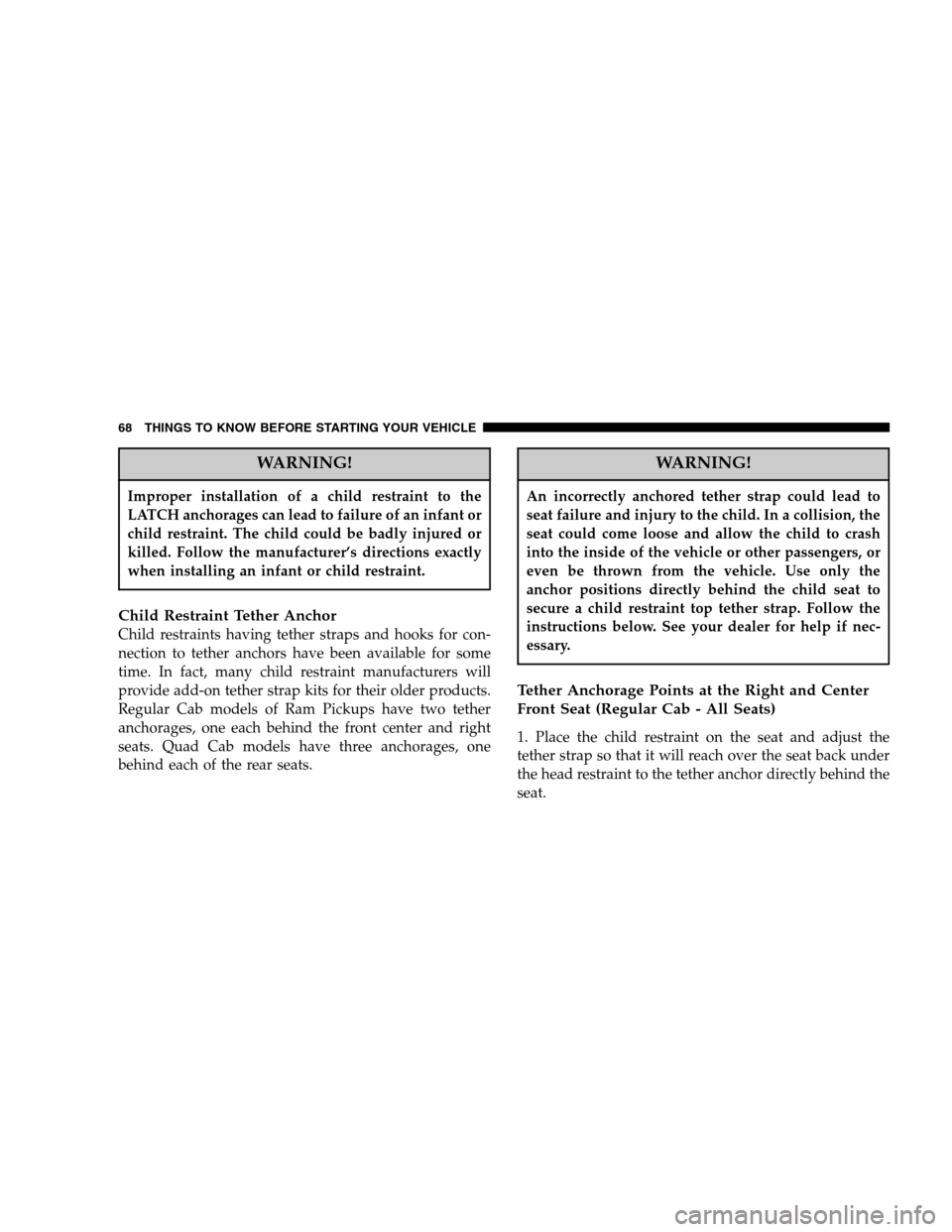Page 68 of 568

WARNING!
Improper installation of a child restraint to the
LATCH anchorages can lead to failure of an infant or
child restraint. The child could be badly injured or
killed. Follow the manufacturer’s directions exactly
when installing an infant or child restraint.
Child Restraint Tether Anchor
Child restraints having tether straps and hooks for con-
nection to tether anchors have been available for some
time. In fact, many child restraint manufacturers will
provide add-on tether strap kits for their older products.
Regular Cab models of Ram Pickups have two tether
anchorages, one each behind the front center and right
seats. Quad Cab models have three anchorages, one
behind each of the rear seats.
WARNING!
An incorrectly anchored tether strap could lead to
seat failure and injury to the child. In a collision, the
seat could come loose and allow the child to crash
into the inside of the vehicle or other passengers, or
even be thrown from the vehicle. Use only the
anchor positions directly behind the child seat to
secure a child restraint top tether strap. Follow the
instructions below. See your dealer for help if nec-
essary.
Tether Anchorage Points at the Right and Center
Front Seat (Regular Cab - All Seats)
1. Place the child restraint on the seat and adjust the
tether strap so that it will reach over the seat back under
the head restraint to the tether anchor directly behind the
seat.
68 THINGS TO KNOW BEFORE STARTING YOUR VEHICLE
Page 88 of 568

Here are some simple steps you can follow to minimize
the risk of harm from a deploying airbag.
•Children 12 years and under should ride buckled up in
a rear seat, if available.
•Infants in rear facing child restraints mustNEVER
ride in the front seat of a vehicle with a passenger front
airbagunless the airbag is turned off(Standard Cab
Vehicles Only). An airbag deployment can cause se-
vere injury or death to infants in that position. See the
Passenger Airbag On/Off Switch section.
•If your vehicle does not have a rear seat, see the
Passenger Airbag On/Off Switch section.
•Children that are not big enough to properly wear the
vehicle seat belt (see section on Child Restraints)
should be secured in the rear seat in child restraints or
belt-positioning booster seats. Older children who do
not use child restraints or belt-positioning booster
seats should ride properly buckled up in the rear seat.
Never allow children to slide the shoulder belt behind
them or under their arm.
•All occupants should use their seat belts properly.
•The driver and front passenger seats should be moved
back as far as practical to allow the airbag room to
inflate.
88 THINGS TO KNOW BEFORE STARTING YOUR VEHICLE
Page 99 of 568
Child Restraint
Everyone in your vehicle needs to be buckled up all the
time — babies and children, too. Every state in the United
States and all Canadian provinces require that small
children ride in proper restraint systems. This is the law,
and you can be prosecuted for ignoring it.
Children 12 years and under should ride properly buck-
led up in a rear seat, if available. According to crash
statistics, children are safer when properly restrained in
the rear seats rather than in the front.WARNING!
In a collision, an unrestrained child, even a tiny
baby, can become a missile inside the vehicle. The
force required to hold even an infant on your lap can
become so great that you could not hold the child, no
matter how strong you are. The child and others
could be badly injured. Any child riding in your
vehicle should be in a proper restraint for the child’s
size.
THINGS TO KNOW BEFORE STARTING YOUR VEHICLE 99
2
Page 103 of 568

•If the belt still can’t be tightened, or if pulling and
pushing on the restraint loosens the belt, disconnect
the latch plate from the buckle, turn the latch plate
around, and insert the latch plate into the buckle
again. If you still can’t make the child restraint secure,
try a different seating position.
•Buckle the child into the seat according to the child
restraint manufacturer’s directions.
•When your child restraint is not in use, secure it in the
vehicle with the seat belt or remove it from the vehicle.
Do not leave it loose in the vehicle. In a sudden stop or
collision, it could strike the occupants or seat backs
and cause serious personal injury.
WARNING!
Improper installation can lead to failure of an infant
or child restraint. It could come loose in a collision.
The child could be badly injured or killed. Follow
the manufacturer’s directions exactly when install-
ing an infant or child restraint.
Lower Anchors and Tether for CHildren (LATCH)
Each vehicle is equipped with the child restraint anchor-
age system called LATCH, which stands for Lower
Anchors and Tether for CHildren. LATCH child restraint
anchorage systems are installed in the Standard Cab
passenger seat position and the Quad Cab rear seat
outboard positions. LATCH equipped seating positions
feature both lower anchor bars, located at the back of the
seat cushion, and tether strap anchorages, located behind
the seatback (refer to Child Restraint Tether Anchor later
in this section).
THINGS TO KNOW BEFORE STARTING YOUR VEHICLE 103
2
Page 108 of 568

WARNING!
An incorrectly anchored tether strap could lead to
seat failure and injury to the child. In a collision, the
seat could come loose and allow the child to crash
into the inside of the vehicle or other passengers, or
even be thrown from the vehicle. Use only the
anchor positions directly behind the child seat to
secure a child restraint top tether strap. Follow the
instructions below. See your dealer for help if nec-
essary.
Tether Anchorage Points at the Right and Center
Front Seat (Regular Cab - All Seats)
1. Place the child restraint on the seat and adjust the
tether strap so that it will reach over the seat back under
the head restraint to the tether anchor directly behind the
seat.2. Lift the cover (if so equipped), and attach the hook to
the square opening in the sheet metal.
3. Install the child restraint and remove the slack in the
tether strap according to the manufacturer’s instructions.
Regular Cab Tether Strap Mounting
108 THINGS TO KNOW BEFORE STARTING YOUR VEHICLE
Page 118 of 568

▫Recalibrating The Compass..............184
▫Outside Temperature...................186
�Garage Door Opener — If Equipped.........186
▫Programming HomeLink................188
▫Canadian Programming/Gate Programming . . 190
▫Using HomeLink.....................191
▫Erasing HomeLink Buttons..............192
▫Reprogramming a Single HomeLink Button . . . 192
▫Security............................192
�Power Sunroof — If Equipped.............193
▫Open Sunroof - Express Mode............194
▫Comfort Stop........................194
▫Closing Sunroof - Express...............194▫Pinch Protect Feature...................194
▫Pinch Protect Override.................195
▫Venting Sunroof - Express...............195
▫Sunshade Operation...................195
▫Wind Buffeting.......................195
▫Sunroof Maintenance...................196
▫Sunroof Fully Closed...................196
�Electrical Power Outlets..................196
�Cigar Lighter And Ash Receiver............198
�Cupholders...........................199
▫Front Instrument Panel Cupholders
(40–20–40 Seats) — Automatic Transmission . . 199
▫Front Instrument Panel Cupholders
(Bucket Seats) — Automatic Transmission....201
118 UNDERSTANDING THE FEATURES OF YOUR VEHICLE
Page 158 of 568
Folding Rear Seat (Kneel Mode) — Mega Cab
Models
Both the left and right rear seats can be folded flat (Kneel
Mode) and used for carrying cargo. Each of the rear seatbacks provide 2 D-rings and each of the rear storage bin
lids provide 2 slotted cutouts. Use a cargo tie down to
secure cargo in the cargo carrying area.
Table Mode
Securing Cargo
158 UNDERSTANDING THE FEATURES OF YOUR VEHICLE
Page 159 of 568
WARNING!
•It is extremely dangerous to ride in a cargo area,
inside or outside of a vehicle. In a collision,
people riding in these areas are more likely to be
seriously injured or killed.
•Do not allow people to ride in any area of your
vehicle that is not equipped with seats and seat
belts.
•Be sure everyone in your vehicle is in a seat and
using a seat belt properly.
WARNING!
Cargo must be securely tied down before driving
your vehicle. Improperly secured cargo can fly
around in a sudden stop and strike someone in the
vehicle, causing serious injury or possible death.
Secure cargo with a cargo tie down using the
D-Rings provided on the back of the seats and the
slotted cutouts in the rear storage bin lid.
UNDERSTANDING THE FEATURES OF YOUR VEHICLE 159
3